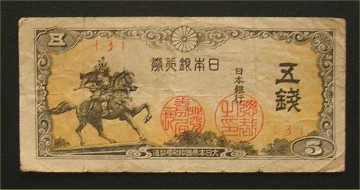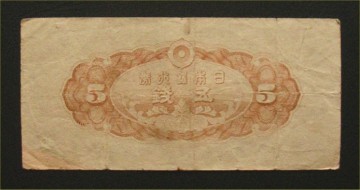 |
 |
Face value : 5 Sen 
Design : Kusunoki Masashige image of horse riding appearance.
Issue : 1944 (Showa era, year 19), Abolition : December, 1953 (Showa era, year 28)
Size : 48mm X 100mm
|
 Kusunoki Masashige (1294-1336) was a 14th century samurai who fought for Emperor Go-Daigo in his attempt to wrest rulership of Japan away from the Kamakura shogunate, then under the leadership of the Hojo clan.
Kusunoki Masashige (1294-1336) was a 14th century samurai who fought for Emperor Go-Daigo in his attempt to wrest rulership of Japan away from the Kamakura shogunate, then under the leadership of the Hojo clan.
A brilliant tactician and strategist, Kusunoki's cunning defense of two key loyalist fortresses at Akasaka and Chihaya helped allow Go-Daigo to briefly return to power. However, one of the loyalist generals, Ashikaga Takauji, betrayed Go-Daigo and led an army against Kusunoki and the remaining loyalists. Kusunoki suggested to the Emperor that they take refuge on sacred Mount Hiei and allow Takauji to take Kyoto, only to swoop down from the mountain, and with the help of the monks of Mount Hiei, trap Takauji in the city and destroy him. Go-Daigo was unwilling to leave the capital however, and insisted that Kusunoki meet Takauji's superior forces in the field in a pitched battle. Kusunoki, in what would later be viewed as the ultimate act of samurai loyalty, obediently accepted his Emperor's foolish command and knowingly marched his army into almost certain death. The battle, which took place at Minatogawa in modern-day Chuo-ku, Kobe, was a disaster. Kusunoki, his army completely surrounded, committed suicide along with 600 of his surviving troops. According to legend, his last words were Shichiu Hokoku! ("Would that I had seven lives to give for my country!")
After the full-scale introduction of Neo-Confucianism as a state philosophy by the Tokugawa Shogunate, Kusunoki Masashige, once-called a traitor by the Northern Court, was resurrected with Emperor Go-Daigo as a precursor of Sinocentric absolutists, based upon the Neo-Confucian theories. During the Edo period, scholars and samurai who were influenced by the Neo-Confucian theories created the legend of Kusunoki, and enshrined him as a patriotic hero, called Nanko or Dai-Nanko, who epitomized loyalty, courage, and devotion to the Emperor. Kusunoki became a patron saint of sorts to the World War II kamikazes, who saw themselves as his spiritual heirs in sacrificing their lives for the Emperor.
|
Copyright © 2005-2020 Nippon Kindai Banknote. All Rights Reserved.
|